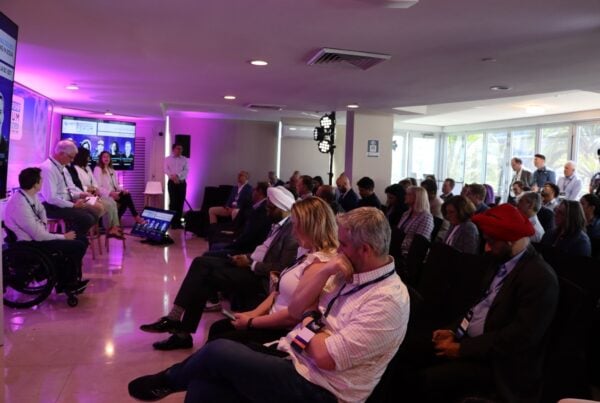Following the publication of a new MEF whitepaper on the topic, Andrew Parkin-White, MEF Advisor on IoT, discusses key issues on market development in IoT global connectivity with an expert panel including:
- BICS – Fernando Llobregat Baena, Head of IoT Sales for Enterprise
- JT Global – Graham Hart Ives, IoT Sales Director
- Pod Group –Amy Garcia, Group Director of Marketing
- Tata Communications – Ben Banister, Director Mobility and IoT Services
- ZARIOT- Stuart Mitchell, Chief Evangelist and Head of Product
IoT global connectivity is an attractive and rapidly growing market.
Market size always generates a great deal of interest and there are many analyst forecasts available. A consistent theme is that of a large and growing market. Specialist IoT analyst firm Transforma Insights forecasts that the IoT market in 2030 will be worth $1.5trn with over 25bn active devices. Connections over cellular will grow from 1.2bn in 2019 to 4.7bn in 2030. Connectivity typically accounts for around 10% of the overall value with some variation by segment and geography.
High mobility applications and healthcare are driving growth
Ben sees the global IoT connectivity market for Tata Communications as anything that moves – automotive, transportation. He notes that there has been considerable impact in some segments from Covid-19, notably airlines – although medical devices have seen growth due to this. Amy confirms the need for connected healthcare products during the pandemic and supply chain has also seen an upside. She is seeing rapid growth from digitisation in manufacturing with Industry 4.0. Increased efficiency and reduced costs are the key drivers. Stuart points out that asset tracking and environmental applications as important segments and sees strong demand in the future.
Developed markets are strong at present with a large emerging opportunity in developing markets
There is consensus in the panel that more developed markets are ahead at present Fernando points to Asia Pacific as the main vector of growth for demand generation with Europe and the United States also being important markets. Amy says that Asia is a huge growth market due to hardware manufacturers and OEMs there – particularly in China Emerging markets will represent the next wave of opportunity. Ben sees substantial activity in India in the smart city space as well as smart grid and automotive.
MNOs may not be prepared to invest in networks to support IoT roaming and may be reluctant to become systems integrators bringing together technologies that are not their own.“
CSPs have hurdles to overcome in addressing the global IoT connectivity market
Graham identifies some challenges – not being able to offer permanent roaming in Brazil and Turkey is an issue, as is the US with MNOs being stricter about devices allowed on their networks. Ben points out that only 20% of IoT connections will be over cellular and other technologies are used depending on the application.
MNOs may not be prepared to invest in networks to support IoT roaming and may be reluctant to become systems integrators bringing together technologies that are not their own. Fernando says that the regulatory environment can prove challenging for IoT CSPs and delivering complete solutions while moving up the value chain is a further challenge.
As an MVNO, Stuart sees a challenge in emerging markets with pricing is not appropriate to the local market and unlocking these markets is dependent on this. Amy sees the fragmentation of the technology market is an issue causing complexity for customers and CSPs and the ability to support multiple technologies into one platform is key.
Enterprises need a value added approach for IoT
Amy believes that enterprises need additional value added services beyond simple connectivity – for critical infrastructure requires more advanced security services like threat detection and monitoring. Stuart says that taking away the complexity is important to make it simple for customers to build a solution and should leverage the CSP’s in issues such as cloud integration and security.
Ben states that enterprises understand their own requirements but lack expertise in cellular communications and are looking for ways to increase the value of their business and understand the information they generate. Analytics are important in this respect. Deriving value from billing, management and provisioning is a growing need. Fernando’s stresses that integration is key and automation of provisioning and access control is important. Graham’s view is that enterprises are looking to reduce costs in processes and want to add value for the future. Solutions can last five to ten years and a provider needs to be a trusted best friend to support them.
CSPs need to differentiate rather than competing on price
Stuart says that differentiation is happening in the areas of technical capabilities, commercial flexibility, wrap around care or additional value adds from OSS and BSS. Ben feels that different industries have different requirements and CSPs can focus where they have strengths. Graham says competing on price is not a preferred strategy but focus on adding value is the way forward.
Fernando states that the IoT market is growing market and not yet commoditised but this may happen in time.
Security or IP traffic control represent examples of ways of differentiating rather than competing on price. Amy believes that MVNOs can provide global coverage being agnostic and offering a single platform but, unlike the MNOs, do not own the core network or spectrum. She sees a shift emerging with new offerings including ESIM and private LTE with an opportunity for CSPs to provide managed services to enterprises. Many enterprises do not have the in-house capability and look to CSPs to work with them as a long-term partner.
What does it take to be successful to monetise the opportunity?
Fernando believes that offering flexibility from the technical and commercial perspective . Graham thinks that reach in having the most networks and largest types of access is important in addition to flexibility. Ben states that understanding customer requirements and the ecosystem in which they are operating is key to adding value. Stuart’s view is that building a niche, such as managed services for the enterprise or security is important as is the ability to scale. Amy is of the opinion that a CSP should be helping the customer to achieve the required ROI they are looking for and be the long- term technology partner of an enterprise.
The Future Of Global IoT Connectivity
In conjunction with its members, MEF has undertaken research into the current position and evolution of the market for global IoT connectivity.
The focus of the research is to explore key issues and questions around the development of the global mobile IoT connectivity ecosystem.
Download now






